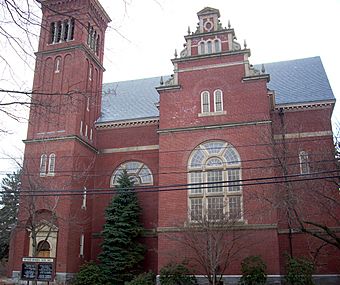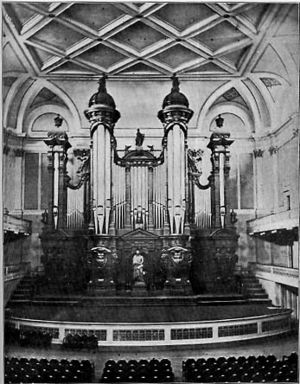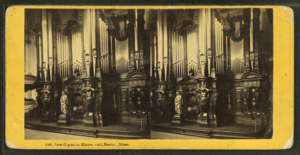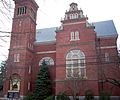Methuen Memorial Music Hall facts for kids
Quick facts for kids |
|
|
Methuen Memorial Music Hall
|
|

Methuen Memorial Music Hall
|
|
| Location | 192 Broadway Methuen, Massachusetts |
|---|---|
| Built | 1909 |
| Architect | Henry Vaughan |
| NRHP reference No. | 78000462 |
| Added to NRHP | December 14, 1978 |
The Methuen Memorial Music Hall, first called Searles Organ Hall, is a special building in Methuen, Massachusetts. It was built by Edward Francis Searles to hold a huge musical instrument called "The Great Organ." This amazing pipe organ was originally made for the Boston Music Hall. The building was finished in 1909 and is located at 192 Broadway.
Contents
The Great Organ
"The Great Organ" was built by the E.F Walcker Company in Ludwigsburg, Germany. It arrived in the United States in March 1863 and was fully set up by November 1863. At that time, people thought it was the biggest pipe organ in the entire country. Today, it has an incredible 6,088 pipes and 84 different sounds, called registers. It was the first organ in the U.S. made for concerts and was placed in the Boston Music Hall.
The outside part of the organ, called the case, was made from American black walnut wood. It was built by the Herter Brothers of New York. The design for the case came from Hammatt Billings. The shiny pipes you see on the outside are made from polished tin from Cornwall.
How the Organ Moved
In 1881, the Boston Symphony Orchestra was started, and they used the Boston Music Hall as their first home. The orchestra needed a lot of space for all their musicians. As orchestral concerts became more popular, people became less interested in organ concerts. Because of this, the organ was taken apart and put into storage in 1884.
Later, it was sold for $5,000 to a person named William O. Grover. He probably wanted to give the organ to the New England Conservatory of Music. But after he passed away around 1897, the organ was sold again to settle his estate. Edward Francis Searles bought it at an auction for $1,500. After buying it, he decided to build a special music hall in Methuen just for this organ.
Building the Music Hall
In 1899, Searles hired Henry Vaughan, a famous architect who designed churches. Vaughan often worked for Searles on different projects. Searles asked him to design a concert hall for the organ on his land next to the Spicket River. It's quite unique because not many buildings this big have been built just to hold one pipe organ.
Outside the Hall
The outside of the building is made of brick and looks like an Anglo-Dutch style. It has a tall, Italian-style bell tower and a fancy gable with curved shapes called volutes. The walls are very thick, more than three feet! They also have air gaps inside, which makes the building very soundproof. This means outside noises don't easily get in.
Inside the Hall
The inside of the hall looks a lot like a church, with a cross-shaped floor plan. A long main aisle leads to a stage in front of the huge pipe organ. Including the organ, the hall is about 100 feet long. Another aisle goes across the front of the stage and out to the sides, making that part about 70 feet wide.
In church terms, the main seating area, called the nave, is 40 feet wide. The parts that stick out on the sides, called the transepts, make it 70 feet wide. The pipe organ is placed in the area usually called the chancel, which is near the altar in a church.
The ceiling is shaped like a half-circle, known as a barrel vault, and is 65 feet high. Below the ceiling, there's a decorative band called an entablature. Hidden lights behind its top edge, called the cornice, shine up and reflect off the ceiling. There's also a narrow walkway, a catwalk, where the ceiling meets the walls. The whole inside space is very large, over 300,000 cubic feet. This large space means that sounds echo for about 4 seconds when the hall is empty, creating a rich sound.
The inside design is in an English baroque style. It was inspired by the Church of Saint Stephen, Walbrook in London, designed by Christopher Wren. The bottom 10 feet of the walls are covered with dark oak paneling. Above that, the walls are made of plaster with special fabric panels. These panels are not just for decoration; they also help to soak up too much echo. The floors are made of marble tiles in a pattern of reddish-brown and gray.
A Look at Its History
After the hall was finished, Edward Searles used it privately until he passed away in 1920. Then, it went to his secretary, Arthur Thomas Walker. Walker died in 1927, and the hall was left to his niece, Ina Cecil McEachran.
In 1930, part of the property, including the hall, was bought by Lillian Wightman Andrew. In 1931, a well-known organ builder named Ernest M. Skinner bought the hall for $10,000.
Under Skinner's ownership, the hall started hosting public concerts. There were choir and organ performances, including music by famous composers like Brahms, Bach, and Handel. Famous organists like Marcel Dupré and E. Power Biggs also played there. In 1936, Skinner started his own organ-building company, "Ernest M. Skinner and Son Company," right next to the music hall.
This company did well at first. They built several important pipe organs, including one for the Washington National Cathedral in Washington, D.C. Interestingly, the National Cathedral was also designed by Henry Vaughan, the same architect who designed the music hall. However, World War II caused the company to struggle. In August 1942, the company's belongings, including the music hall, were given to trustees to protect them from people the company owed money to.
In 1943, a court allowed a bank to sell the property to pay off loans. In June 1943, a fire destroyed the organ factory building next door, but the music hall itself was mostly safe. In July, the bank bought the property at an auction for $55,000.
In May 1946, eight local people started a charity to buy and take care of the music hall. They wanted to run it as a place for cultural events. In 1947, the Aeolian-Skinner Organ Company was hired to rebuild the organ. They changed the organ's sound and added a new, separate control panel.
Visiting Today
Today, the Music Hall holds many concerts and recitals. It also sometimes lets student organists practice on the amazing instrument. Most events happen in the spring and summer, with up to three events each week. The hall is also often rented for weddings and other private parties. For weddings, it's special because it looks like a traditional church but doesn't have any religious symbols or connections.
Images for kids




